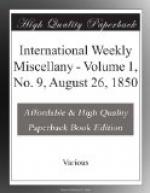“Case of flame!” repeated Mr. Bagges. “Live and learn. I should have thought a candle-flame was as thick as my poor old noddle.”
“I can show you the contrary,” said Harry. “I take this piece of white paper, look, and hold it a second or two down upon the candle-flame, keeping the flame very steady. Now I’ll rub off the black of the smoke, and—there—you find that the paper is scorched in the shape of a ring; but inside the ring it is only dirtied, and not singed at all.”
“Seeing is believing,” remarked the uncle.
“But,” proceeded Harry, “there is more in the candle-flame than the gas that comes out of the candle. You know a candle won’t burn without air. There must be always air around the gas, and touching it like, to make it burn. If a candle hasn’t got enough air, it goes out, or burns badly, so that some of the vapor inside of the flame comes out through it in the form of smoke, and this is the reason of a candle smoking. So now you know why a great clumsy dip smokes more than a neat wax candle; it is because the thick wick of the dip makes too much fuel in proportion to the air that can get to it.”
“Dear me! Well, I suppose there is a reason for everything,” exclaimed the young philosopher’s mamma.
“What should you say now,” continued Harry, “if I told you that the smoke that comes out of a candle is the very thing that makes a candle light? Yes; a candle shines by consuming its own smoke. The smoke of a candle is a cloud of small dust, and the little grains of the dust are bits of charcoal, or carbon, as chemists call it. They are made in the flame, and burnt in the flame, and, while burning, make the flame bright. They are burnt the moment they are made; but the flame goes on making more of them as fast as it burns them: and that is how it keeps bright. The place they are made in, is in the ease of flame itself, where the strong heat is. The great heat separates them from the gas which conies from the melted wax, and, as soon as they touch the air on the outside of the thin case of flame, they burn.”
“Can you tell how it is that the little bits of carbon came the brightness of the flame?” asked Mr. Wilkinson.
“Because they are pieces of solid matter,” answered Harry. “To make a flame shine, there must always be some solid—or at least liquid-matter in it.”
“Very good.” said Mr. Bagges,—“solid stuff necessary to brightness.”
“Some gases and other things,” resumed Harry, “that burn with a flame you can hardly see, burn splendidly when something solid is put into them. Oxygen and hydrogen—tell me if I use too hard words, uncle—oxygen and hydrogen gases, if mixed together and blown through a pipe, burn with plenty of heat but with very little light. But if their flame is blown upon a piece of quick-lime, it gets so bright as to be quite dazzling, Make the smoke of oil of turpentine pass through the same flame, and it gives the flame a beautiful brightness directly.”




